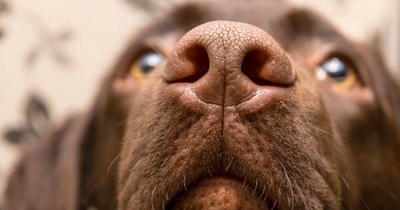Science discovers a newfound nose-to-brain connection that helps to explain why smell and vision connect in a way never described before.
A dog’s brain is wired for smell. Now, a new MRI map shows just how extensive that wiring is.
Powerful nerve connections link the dog nose to wide swaths of the brain, researchers report in the Journal of Neuroscience. One of these canine connections, a hefty link between areas that handle smell and vision, hasn’t been seen before in any species, including humans.
These results offer a first-of-its-kind anatomical description of how dogs “see” the world with their noses. The new brain map is “awesome, foundational work,” according to Eileen Jenkins, a retired army veterinarian and expert on working dogs. “To say that they have all these same connections that we have in humans, and then some more, it’s going to revolutionize how we understand cognition in dogs.”
- We all know that dogs are superb sniffers. Their noses hold between 200 million and 1 billion odor molecule sensors, compared with the 5 million receptors estimated to dwell in a human nose. And dogs’ olfactory bulbs can be up to 30 times larger than people’s. But scientists wanted to know how smell information wafts to brain regions beyond the obvious sniffing equipment.
- After odor information enters the nose, it whizzes to the olfactory bulb, a brain structure that sits behind the dogs’ eyes. But from there, it wasn’t clear where the signals went next. When researchers looked for the tracts in the dog MRI data, they were blown away. [We] “just kept finding these huge pathways. They seem like information freeways running from the nose back into the brain.”

A dog’s nose works in tandem with their eyes to help ‘see’ and understand their environment clearly - This new MRI dog brain map contains some familiar roads, including those that connect the olfactory bulb to brain areas associated with memories and emotions. In people, those roads explain why a whiff of perfume can transport a person back in time. But one tract was totally new. This road, thick and obvious, connected the olfactory bulb to the occipital lobe, the part of the dog brain that handles vision. “There have been lots of people who theorized that this connection existed, based on the behavior of trained dogs and detection dogs, but nobody has been able to prove it. This is fabulous.”
In Everyday Use
“When we walk into a room, we primarily use our vision to work out where the door is, who’s in the room, where the table is. Whereas in dogs, this study shows that olfaction is really integrated with vision in terms of how they learn about their environment and orient themselves in it.”
- The research team found connections where the brain processes memory and emotion, which are similar to those in humans, as well as other never-documented connections to the spinal cord and the occipital lobe that are not found in humans. The research corroborates her clinical experiences with blind dogs, who function remarkably well. “They can still play fetch and navigate their surroundings much better than humans with the same condition. Knowing there’s that information freeway going between those two areas could be hugely comforting to owners of dogs with incurable eye diseases.”
This research opens many new doors for research and the discovery of how remarkable and talented our canine family and friends are!
Youtube video of blind dog playing fetch. [Link] Using hearing, smell, and the handler’s voice, this dog is amazing!
